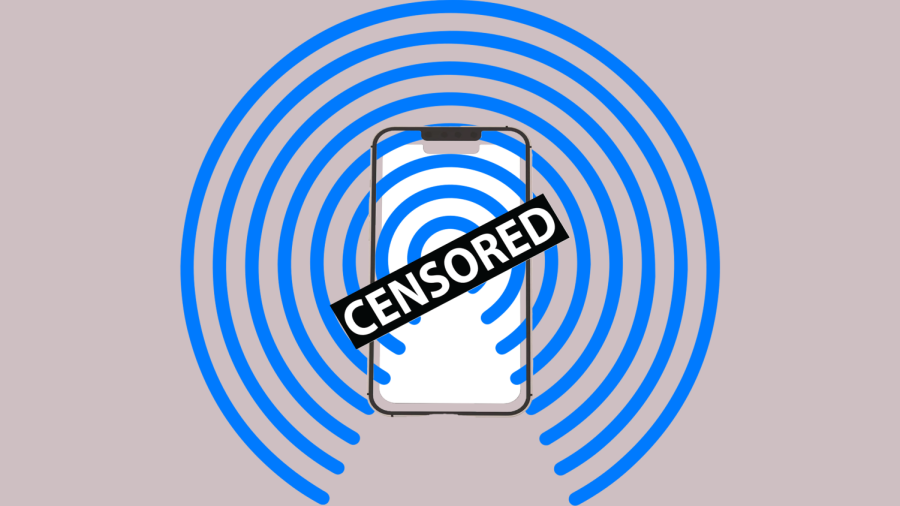Cushman: We Need to Start Taking Cyberflashing Seriously
(Design by Emily Christensen | The Daily Utah Chronicle)
June 17, 2022
The #MeToo movement — an effort to help sexual assault survivors feel less alone and share their stories — became popular on social media around 2017. As a SA survivor myself, it’s been empowering to watch online environments become more willing to believe victims and speak out against abusers. Nonetheless, there is still much to do to make consent a priority of our culture.
This extends to cyberflashing, “the sending of unsolicited nudes.” This form of sexual harassment remains severely under-legislated and doesn’t receive much cultural pushback. Until we start speaking out against sexual harassment in all its various forms, SA will continue to thrive. We need to take action against cyberflashing, culturally and legislatively.
Prevalence of Online Harassment
Cyberflashing doesn’t consider consent or respect for what sexual content people want to see. It forces people into sexual interactions in which they oftentimes don’t have an opportunity to say “no” before sexually explicit images pop up on their screen. The numbers may fluctuate between studies and age groups, but as our world has moved online, sexual harassment has too.
Online harassment is far from a victimless crime. One Pew Research study found that over half “of young women ages 18 to 29 say that someone has sent them explicit images they did not ask for.” A similar study from Bumble found that one in three women have received unsolicited nude photos. Of those women, 96% say they did not want them. Cyberflashing also affects children, with 76% of girls aged 12 to 18 reporting having been cyberflashed by boys and men.
Half of women in that Pew Research study said they believe offensive content online gets excused too often. Compared with 43% of men, 63% of women value a safe and welcoming online environment over an environment that allows people to speak freely. Online harassment directed at women is more often sexual in nature, with cyberflashing being part of that phenomenon.
Long-Term Impacts
Looking specifically at sexual harassment, workplace instances can trigger or worsen depression and anxiety. These symptoms even manifest as physical ailments like headaches or heart problems. Online sexual harassment can make victims feel similarly unsafe and experience the same health ramifications. My personal experiences with cyberflashing changed my online behavior, making me more wary of talking to men on the internet. I feel safer having in-person meetings before sharing my phone number or snapchat. I am forced to take this and other measures just to avoid unwanted sexual content getting directed at me. The effects of cyberflashing might seem small, but I’ve lost my sense of safety in online interactions and spaces. Sexual harassment, no matter how or where it takes place, forces victims to change their behavior and feel unsafe.
Legislative and Cultural Contributors
Despite the potentially crippling effects of cyberflashing, very few laws exist to combat it in the United States. In 2019, Texas became the first — and so far, only — state to make cyberflashing illegal. They made it a class C misdemeanor punishable with a fine up to $500. Other states, like Wisconsin and California, have seen legislators begin drafting similar legislation. Still, in 49 states, cyberflashing, a clear form of sexual harassment, remains completely legal.
Not only is cyberflashing severely underregulated, but it lacks the same cultural pushback that other types of sexual harassment get. Where my friends and I will openly speak about sexual coercion as a form of misogyny and sexual harassment, cyberflashing isn’t treated as such. When one of us receives an unsolicited nude photo, we’re more prone to laugh and brush it off. We have failed to realize how that sexual harassment has affected us and become almost commonplace. It has changed our behavior online in the long term and created an unsafe environment.
When we make light of blatant sexual harassment, we contribute to a culture that doesn’t see a problem with unsolicited sexual advances. We effectively decide that a nonconsensual sexual act lacks severity and deserves laughter. Moreover, we continue to allow misogynistic behavior to exist without consequences and create unsafe spaces for women. We continue to allow predators to endanger children and incur no legal ramifications for doing so. Without accountability, this behavior will inevitably continue.
By treating cyberflashing as a normal part of being online, I have been guilty of perpetuating a culture that doesn’t value the consent and safety of women. We wouldn’t make light of someone flashing another person offline. Why do we treat it any differently online? How can we stand with survivors if we don’t advocate for changing cultural norms that minimize consent and perpetuate rape culture?
I want to be someone who advocates for victims. That means advocating for consent always, both offline and on.









